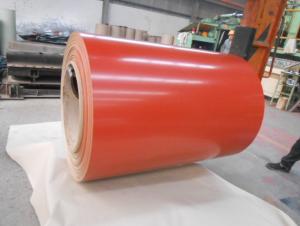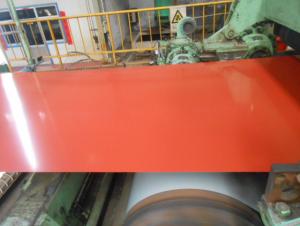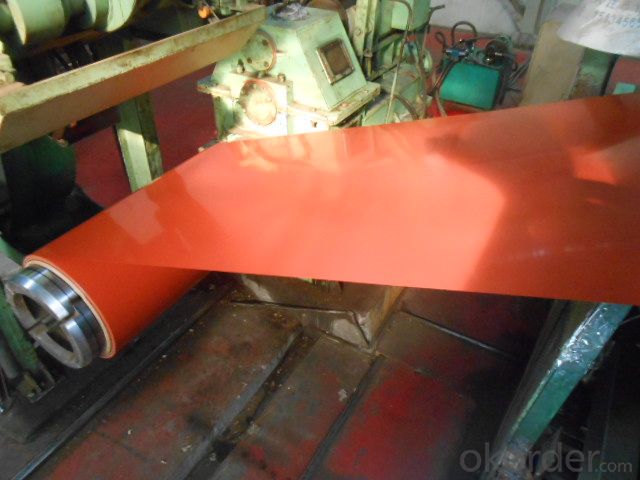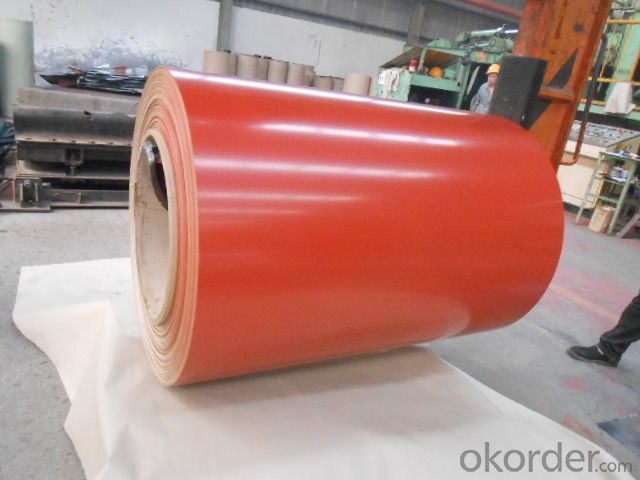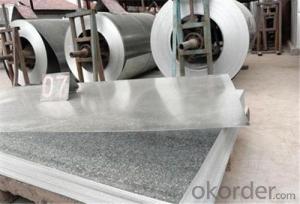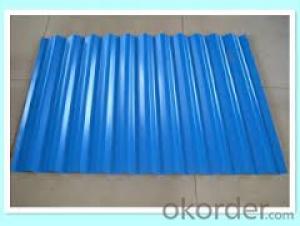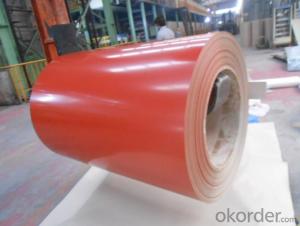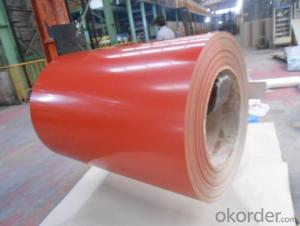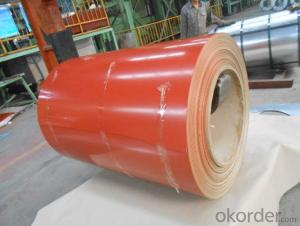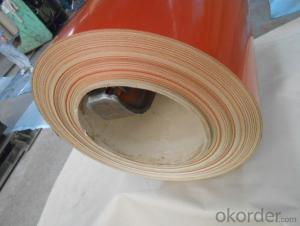Color Coated Steel Sheet/ Coil in Red Color Prime
- Loading Port:
- China Main Port
- Payment Terms:
- TT or LC
- Min Order Qty:
- 50 m.t
- Supply Capability:
- 20000 m.t/month
OKorder Service Pledge
OKorder Financial Service
You Might Also Like
1.Structure of Pre-painted GI/GL Steel Coil Description
With GI (aluzinc) as base metal, after pretreatment (degrease and chemical treatment) and liquid dope with several layers of color, then after firing and cooling, finally the plate steel is called pre-painted galvanized (aluzinc) steel. Pre-painted galvanized steel is good capable of decoration, molding, corrosion resistance. It generally displays workability, durability and weather resistance.
2.Main Features of the Pre-painted GI/GL Steel Coil
• Excellent corrosion resistance
• Excellent weather resistance
• Capability of decoration, molding, corrosion resistance
• Workability, durability
• Excellent heat resistance performance
• High strength
• Good formability
• Good visual effect
3.Pre-painted GI/GL Steel Coil Images
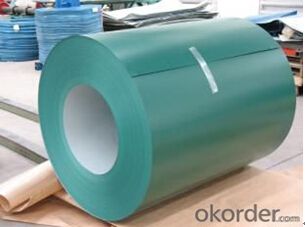
4.Pre-painted GI/GL Steel Coil Specification
Quality standar: JIS G3312 CGCC & CGLCC
Hardness of P: Both soft and hard quality are available
Surface finish: with or without protect film
Thickness : 0.14-1.20 mm
Width : 914mm, 1000mm, 1220mm and 1250mm, thickness 600-1250mm is available
Finish by coil or sheet: Both sheet and coil are available
8Zinc coating: 60-275G/M2, both sides
Paint thickness for top side : 5 micron primer + (10-20) microns modified polyester, green color.
Paint thickness for back side: (5-10) microns Epoxy
Weight per coil: 4-6 tons, also can be upon customer's requirements
Max loading weight in one 20ft container : 25 tons generally
5. FAQ of Pre-painted GI/GL Steel Coil
We have organized several common questions for our clients,may help you sincerely:
1. What is the minimum order quantity ?
Our MOQ is 50mt for each size. And we will consider to give more discount if you make big order like 1000 tons and more. Further more, the more appropriate payment term your offer the better price we can provide.
2. How long can we receive the product after purchase?
Usually within thirty working days after receiving buyer’s advance payment or LC. We will arrange the factory manufacturing as soon as possible. The cargo readiness usually takes 15-25 days, but the shipment will depend on the vessel situation.
3. How to guarantee the quality of the products?
We have established the international advanced quality management system,every link from raw material to final product we have strict quality test;We resolutely put an end to unqualified products flowing into the market. At the same time, we will provide necessary follow-up service assurance.
- Q: How are steel coils tested for mechanical properties?
- Steel coils are tested for mechanical properties through various methods, including tensile testing, hardness testing, and impact testing. Tensile testing involves subjecting a small sample of the steel coil to a controlled force, measuring the amount of force required to deform or break the material. Hardness testing determines the resistance of the steel to indentation or scratching, providing insights into its strength and durability. Impact testing assesses the ability of the steel to withstand sudden loads or shocks by striking a sample with a pendulum and measuring the energy absorbed during fracture. These tests help evaluate the quality and suitability of steel coils for specific applications.
- Q: What is the typical lead time for ordering steel coils?
- The typical lead time for ordering steel coils can vary depending on factors such as the supplier, quantity required, and current market conditions. However, it is common for lead times to range from a few weeks to several months.
- Q: What are steel coils?
- Steel coils are long, flat sheets of steel that are rolled into a circular shape and wound tightly to form a coil. These coils are commonly used in various industries, including automotive, construction, and manufacturing, as they serve as a raw material for the production of various steel products such as pipes, tubing, and sheet metal.
- Q: I'm a Hobbyist and want to Build my own axial-flow jet engine,can I use steel as the Turbine blades instead of Titanium which I can't get easily?? What about the other parts I can use for...?!
- Yes you can use steel but you will want to use super alloys like hastaloy and inconel. These withstand the heat in the combustion areas. These are the actual materials used in these stages. If you only want your engine to have a service life of a few hours a conventional hot work steel like H-13 will probably be OK Blades are investment cast in foundries that carefully control the rate of cooling to create a very uniform grain structure
- Q: Can steel coils be coated with holographic patterns?
- Yes, steel coils can be coated with holographic patterns. The holographic coating can be applied to the surface of the steel coils, creating a visually stunning and unique effect.
- Q: I installed it, added it in F3 launcher and then after one minute of walking in wasteland I get a signal that Broken steel was added and that my level of caps was raised by 30. However after this message no quest is added. I played all 4 exp. packs and I had no problem at all, each time a new quest was added. So whats up with this Broken steel. Btw, I completed the entire game F3.
- It is because Broken Steel doesn't add a new quest. It continues the main story. Once you beat the game, you will see. There is nothing wrong with it.
- Q: Can steel coils be cut or trimmed after delivery?
- Yes, steel coils can be cut or trimmed after delivery. This process is commonly known as slitting, where the steel coil is passed through a set of circular blades to create narrower strips of steel. Trimming can also be conducted to remove any unwanted edges or imperfections. Both cutting and trimming are common practices in the steel industry to meet specific size and shape requirements for various applications.
- Q: What are the common applications of galvanized steel coils?
- Galvanized steel coils are commonly used in a variety of applications, including construction, automotive manufacturing, electrical appliances, and agricultural equipment. They are particularly useful for roofing and siding materials, as well as for creating durable and corrosion-resistant components in various industries.
- Q: What are the different methods of storing steel coils?
- There are several different methods of storing steel coils, including vertical stacking, horizontal stacking, eye-to-the-sky stacking, and interlocking stacking. Each method has its own advantages and considerations based on factors such as space availability, weight distribution, and accessibility for transportation and handling. Ultimately, the choice of storage method depends on the specific requirements and constraints of the steel coil storage facility.
- Q: How are steel coils inspected for weldability?
- Steel coils are inspected for weldability using various methods, such as visual examination, non-destructive testing (NDT) techniques like ultrasonic testing or magnetic particle inspection, and chemical analysis. These inspections help identify any surface defects, internal discontinuities, or impurities that may affect the weldability of the steel coils.
Send your message to us
Color Coated Steel Sheet/ Coil in Red Color Prime
- Loading Port:
- China Main Port
- Payment Terms:
- TT or LC
- Min Order Qty:
- 50 m.t
- Supply Capability:
- 20000 m.t/month
OKorder Service Pledge
OKorder Financial Service
Similar products
Hot products
Hot Searches
Related keywords

